Phiên bản AdGuard DNS
AdGuard DNS
Release
4 thg 12, 2025
AdGuard DNS v2.18 brings a significant improvement to Parental control. Previously, it could block specific domains or individual content types, but larger groups of services were harder to manage. In this update, we’ve introduced category-based service blocking — a new, more convenient way to control access to predefined groups.
Available categories
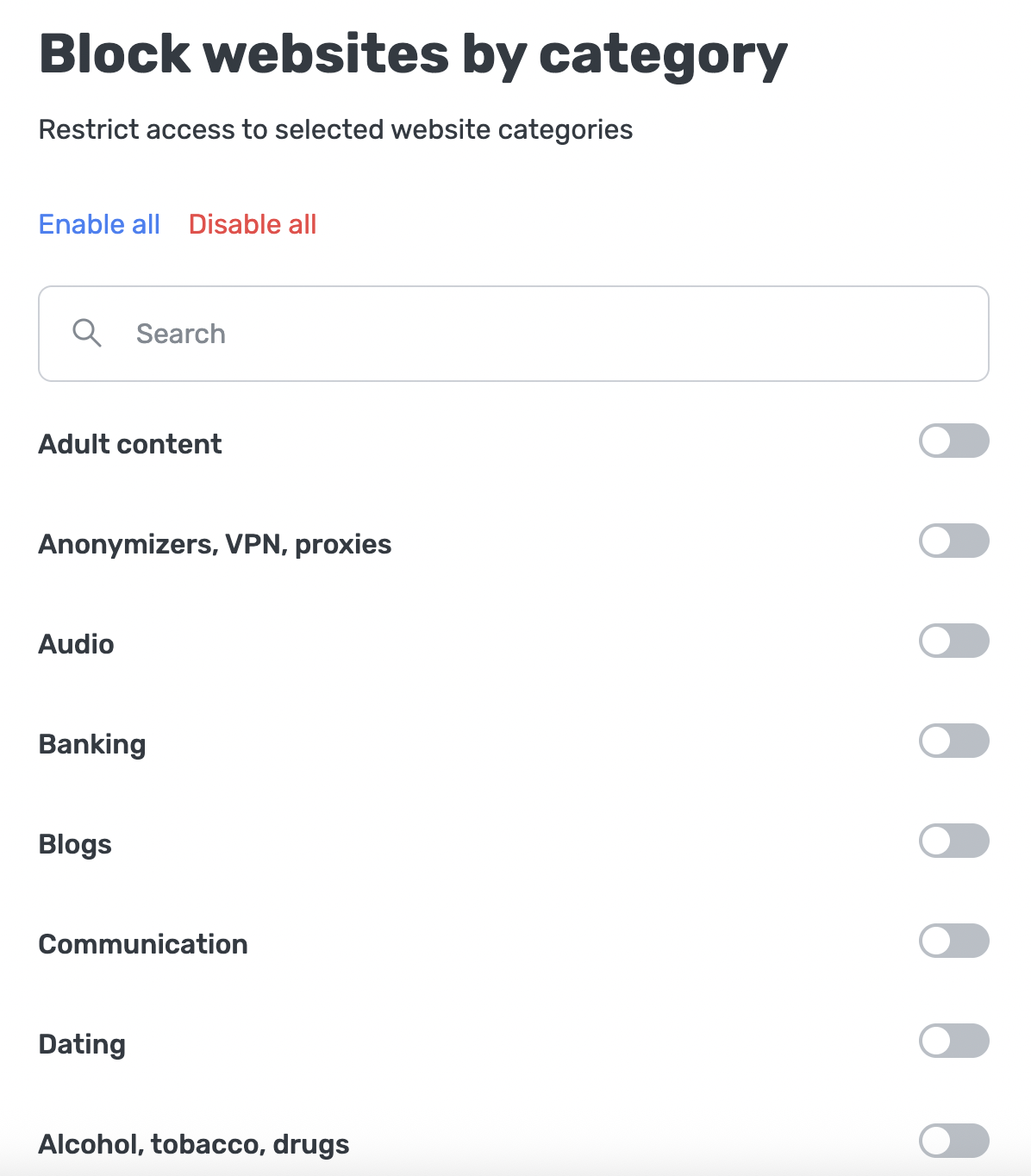
You can choose from more than 20 blocking categories, including:
Adult content: Websites and services containing explicit material or other 18+ content.
Games: Websites, platforms, and services related to online gaming, game downloads, gaming communities, and in-browser games.
Banking: Online services of financial institutions, including banking portals, credit-card services, loan providers, and investment platforms.
Communication: Platforms for messaging, calling, collaboration, or social interaction, such as messengers, video-conferencing tools, and forums.
And many others!
Why it’s useful
Overall, category-based filtering makes Parental control easier to configure, more flexible, and more effective for both home and business use.
Families can set up protection much more easily: instead of hunting for individual domains to block, parents can simply choose a category and be confident that related content is filtered automatically. It offers peace of mind, saves time, and helps maintain a safer online environment for children.
Corporate users gain similar advantages. Category-based blocking allows administrators to enforce company policies consistently. It simplifies setup, reduces maintenance efforts, and helps ensure compliance with organizational security or productivity guidelines.
How to use it
On your Dashboard, go to Servers.
Select the desired server and click Parental control.
Go to Block websites by category.
Search for the categories you want to block or select them directly from the list.
You’re ready to go!
5 thg 11, 2025
AdGuard DNS v2.17 is mainly targeted at advanced users and corporate clients. This update introduces API key access to the AdGuard DNS API, enabling secure and seamless integration with third-party services. It also adds the ability to customize block pages that appear when users try to access dangerous or restricted sites.
Secure integration with API keys
We’re improving the access system for the AdGuard DNS API by transitioning from using account credentials (username and password) to API keys for authentication.
What is the AdGuard DNS API?
The API allows you to manage AdGuard DNS settings without logging into the web interface, enabling you to control it through code or automation. You can, for example, add domains to the blocklists, enable or disable filters, get query statistics, or configure DNS for multiple devices. This is especially useful for integrations, scripts, and home automation systems.
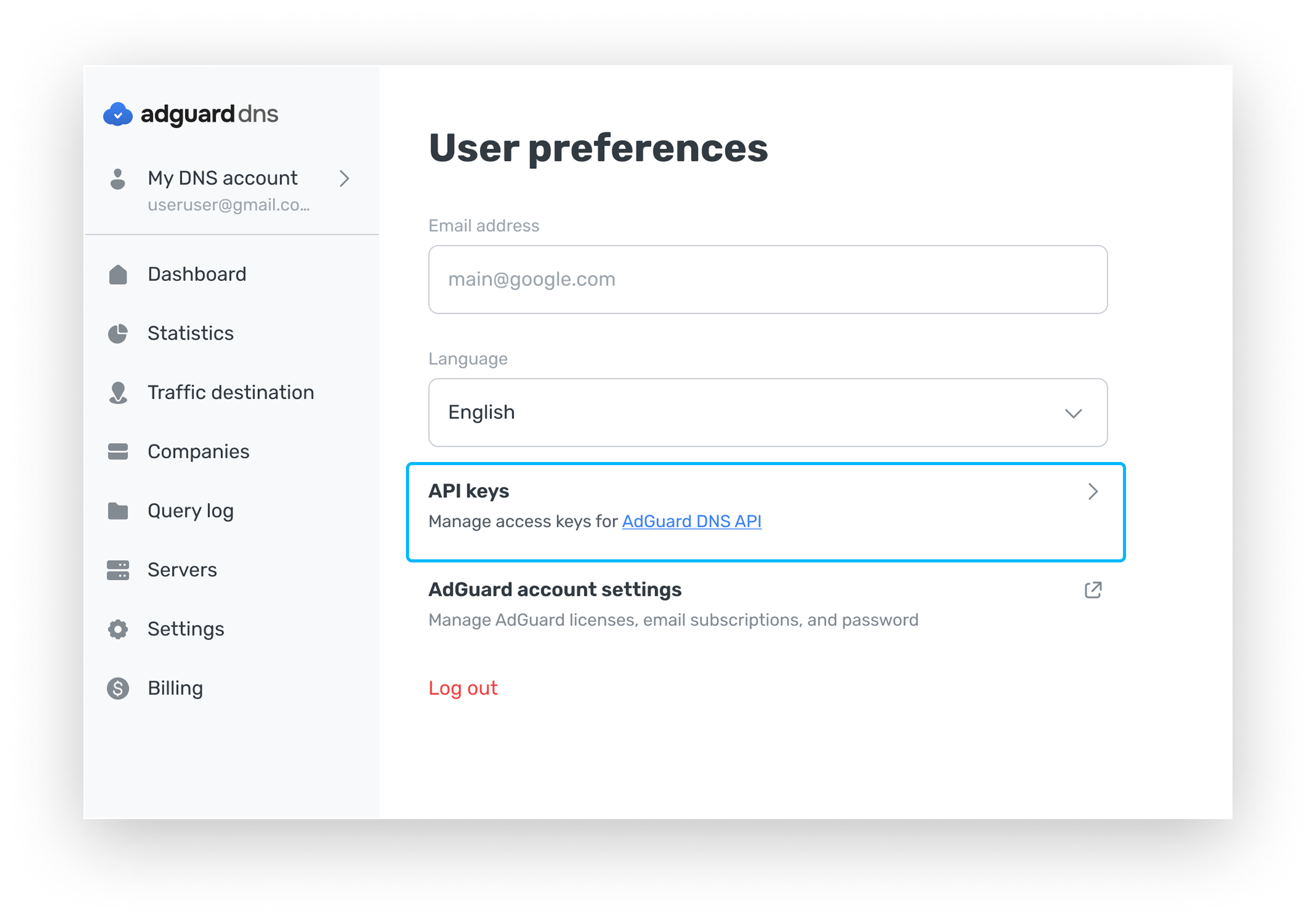
Previously, API access required a login and password, which was not ideal. Passwords can end up in logs or unauthorized hands, which puts your account at risk.
API keys solve this problem. They can be created for specific tasks, used only for API access, and revoked or replaced quickly if necessary. This new approach offers a more secure and manageable way to provide access to the API, and it simplifies integrations with external services.
Customizable block pages
We’ve added the ability to show custom block pages for phishing or adult websites. Instead of the standard AdGuard DNS block page, you can now display your own custom page.
This is particularly useful for businesses, schools, or any organizations using AdGuard DNS. If you need to brand the block page with your logo, contact details, or a custom message for users, this functionality allows you to do so.
To enable custom block pages, go to Parental control or Security settings, and under Respond to blocked domain, select Custom IP, and add the IP address of your custom page.
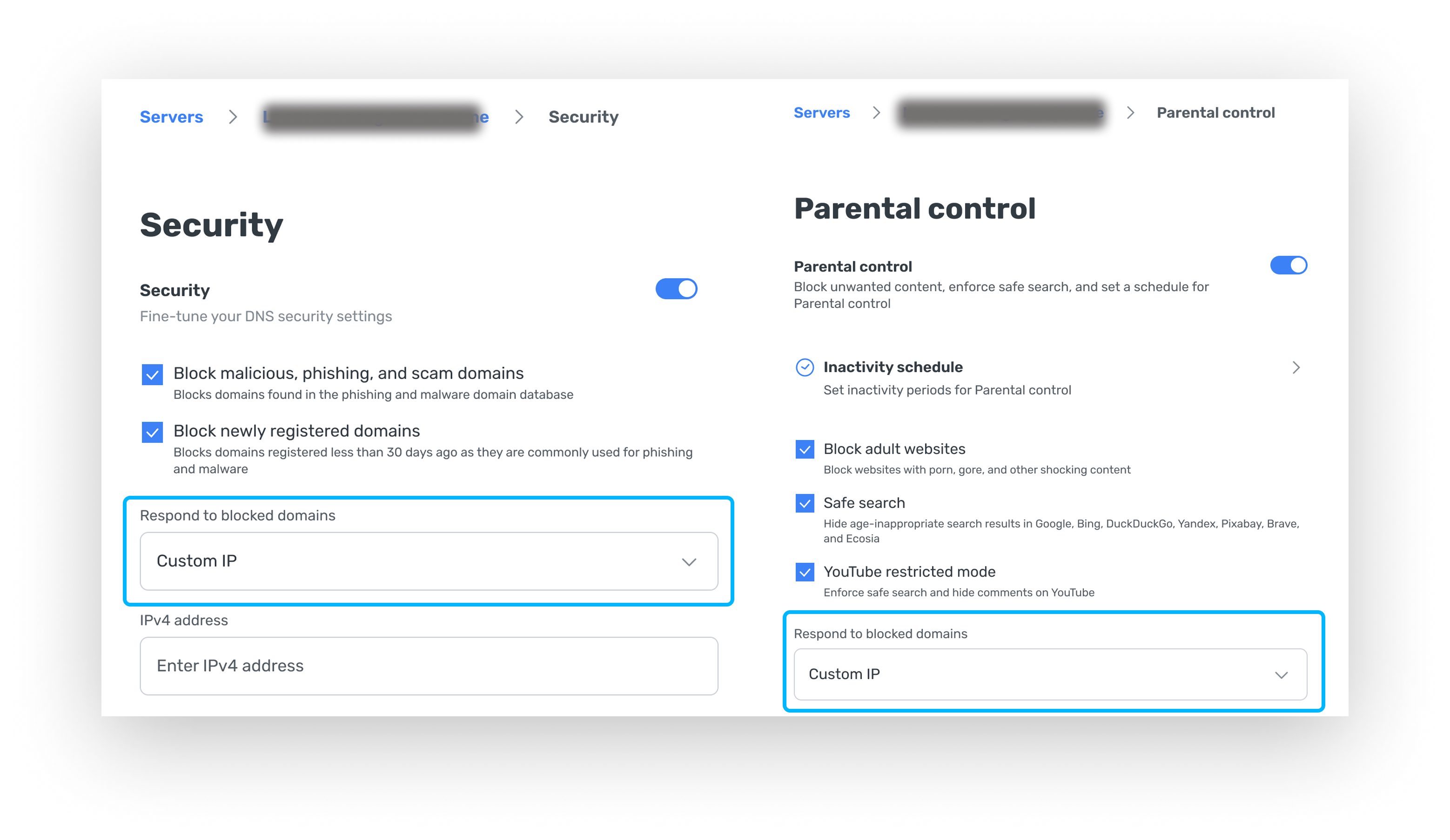
Note: This feature is available for users with the Team and Enterprise subscriptions.
If you have any ideas or suggestions for future features, feel free to share them with us on GitHub.
26 thg 9, 2025
Version 2.16 introduces role-based access for DNS accounts.
Instead of sharing credentials, owners can now invite members with individual roles. This makes DNS management more secure and convenient: each member uses their own credentials, and billing remains under the owner’s control.
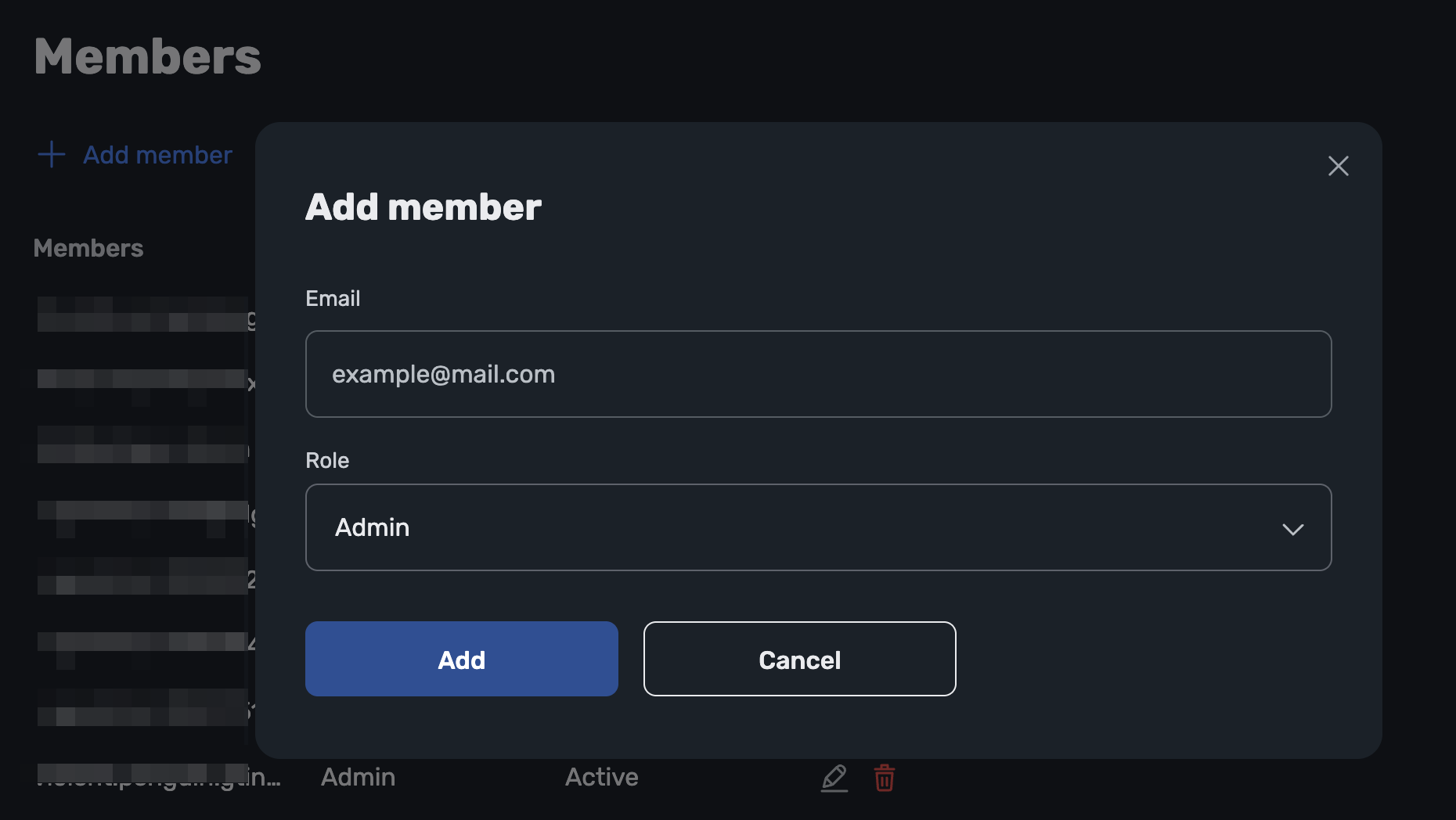
Admins can now switch between multiple DNS accounts with a single login. This is especially useful for system administrators and MSPs who support several organizations at once.
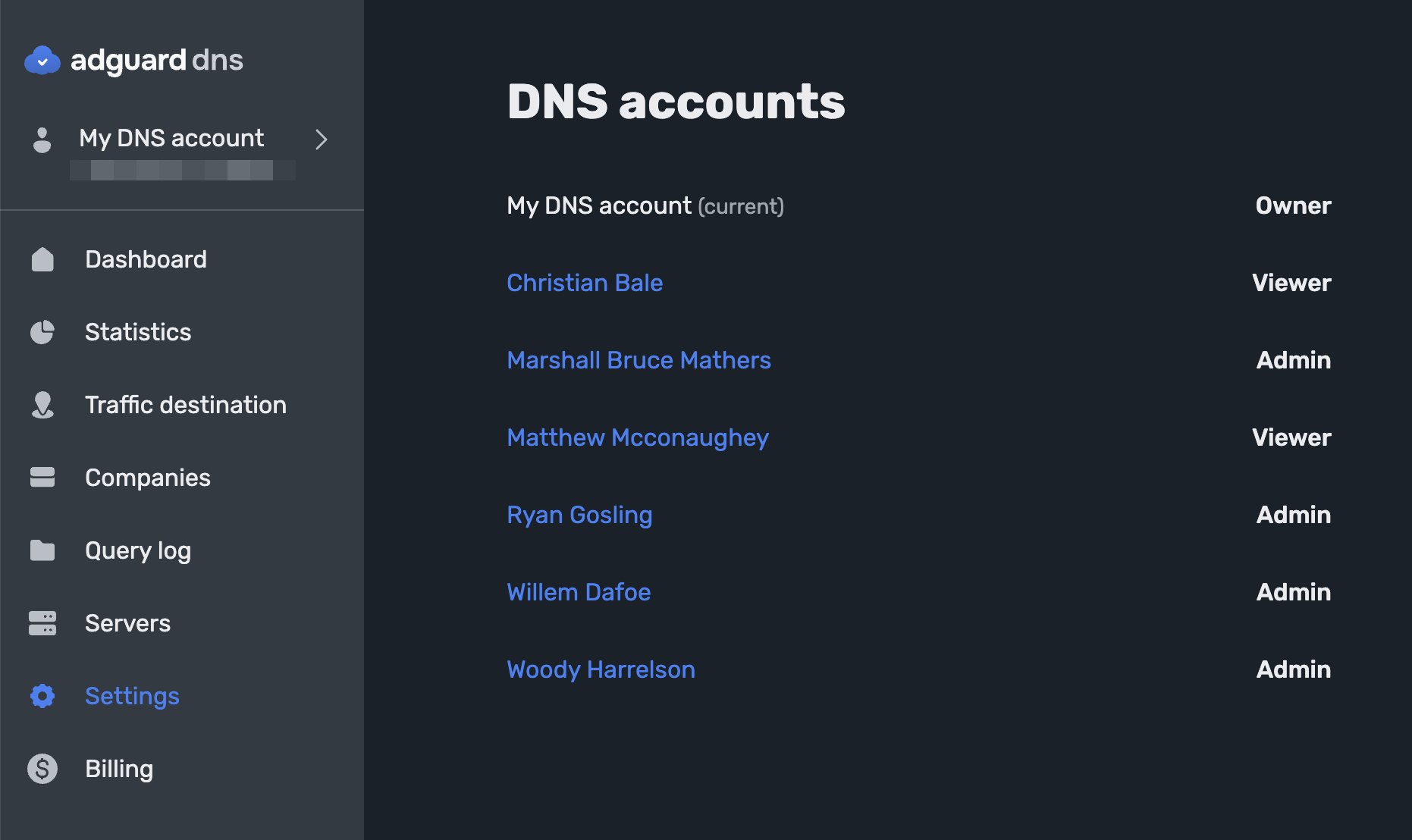
Types of members
DNS accounts now support three access levels. Ownership is fixed at registration, while admins and viewers are added through invitations. Roles can be updated or revoked at any time, and the number of members is virtually unlimited.
Owner — the account holder with full access to all settings and billing
Admin — a member who can modify DNS settings, manage devices, and invite other members
Viewer — a member with read-only access. Can view settings and statistics but cannot make changes
How to invite members
Go to your dashboard → Settings.
In the Organization section, open Members.
Click Add member, enter your colleague’s email address, and select the access type — admin or viewer.
Wait until they accept the invitation, and you’re ready to collaborate!
Only owners and admins can invite new members. To use this feature, you need a Team or Enterprise subscription and a Business account type.
20 thg 8, 2025
This update builds on the previous one and takes it a step further. In version 2.15, we introduced custom domains. In version 2.15.1, we’re making them more accessible.
Custom domains are now available for Team subscriptions, not just Enterprise ones. This makes it easier for small businesses to set up branded addresses.
We’ve also added a quick setup guide for custom domains in Account settings.
Changelog
Improvements
Enabled configuration of custom domains for users with a Team subscription
Added a setup guide for custom domains
Fixes
Fixed inconsistencies in the Statistics section
8 thg 7, 2025
If your company wants to use a branded domain instead of the default
d.adguard-dns.com, we have good news for you: AdGuard DNS now supports custom domains. This feature is perfect for businesses looking to integrate DNS protection seamlessly into their existing infrastructure.Custom domains
Some companies prefer to use their own domain names for DNS services, whether for branding, compliance, or internal IT policies. With AdGuard DNS v2.15, Enterprise subscribers can now set up custom domains (e.g.,
example.com) for DoH, DoT, or DoQ. This ensures a consistent experience while maintaining full ad-blocking and privacy protection.How to set up a custom domain
To configure a custom domain, log in to your AdGuard DNS dashboard and go to Account settings. Scroll down to Advanced settings and select Custom domains. Next you will need to go through three main steps: the protocol, CNAME, and certificates.
Choose the protocol. Here, you have two options:
Add DoH domain (for DNS-over-HTTPS)
Add DoT/DoQ domain (for DNS-over-TLS or DNS-over-QUIC)

After selecting your preferred protocol, enter the preferred domain name (e.g.,
example.com) and verify the CNAME record.
Set up a certificate. For DoT/DoQ domains, you’ll need to upload a wildcard TLS certificate. If you choose DoH, you can either provide your own TLS certificate or let AdGuard DNS generate one for you. Once verified, your custom domain will appear in the dashboard, ready for use.

Important note
Custom domains are currently available only for Enterprise subscription, but we plan to expand support to Team plan in future updates.
We hope this update makes AdGuard DNS even more flexible for businesses. Have feedback or feature requests? Share them on GitHub.
22 thg 5, 2025
At AdGuard, we follow a simple principle: the final decision is always yours — but it should be an informed one.
In line with this, version 2.14 introduces a new warning that appears when you try to add a problematic blocklist — the one that may cause some websites to work incorrectly.

What makes a blocklist problematic?
AdGuard DNS includes a curated set of blocklists. The number is limited, but not strictly — if you know a useful list that we don’t offer yet, you’re welcome to suggest it. Just follow this GitHub guide.
Some third-party blocklists can be very strict — for example, they may block anything that even slightly compromises your privacy. While powerful filtering can be great, it may also break certain websites.
Ultimately, the choice is yours — but as the saying goes, forewarned is forearmed.
25 thg 3, 2025
Version 2.13 introduces two major usability improvements: better handling of large numbers of devices and more convenient selectors in Query log.
Improved device display
If you manage DNS for an enterprise, your servers may eventually handle hundreds or even thousands of connected devices. Prior to this release, viewing statistics for such a large number of devices on the main screen was inconvenient — they were all displayed in one long, continuous list.
To make it easier to find the device you need, we’ve added pagination and device search.

Enhanced Query log selectors
Query log provides the most detailed data about your requests, and to analyze it effectively, you need powerful filtering tools. Here’s what we’ve improved in this update:
Revised selectors. We’ve increased the width of the selectors so you can see more information at a glance without having to click through.
Added a server selector. Now you can filter request statistics by specific servers.
Improved the device selector. You can now search for devices and select multiple devices at once.

We hope that these changes will make AdGuard DNS even more convenient to use. Do you have any ideas for further improvements? Feel free to share them with us via GitHub Issues.
Changelog
Improvements
Query log: Added multi-select support for device and server selectors
Fixes
Dashboard freezes when too many devices are connected
21 thg 1, 2025
If you haven’t tried AdGuard DNS yet or if you have friends who want to block ads as well, we have good news for you: AdGuard DNS now offers free trials on all plans. Here’s how it works.
After you sign up, we’ll ask you about your intended use for AdGuard DNS: is it for home or business? For home use, we’ll immediately offer you a 30-day trial of the Personal plan.
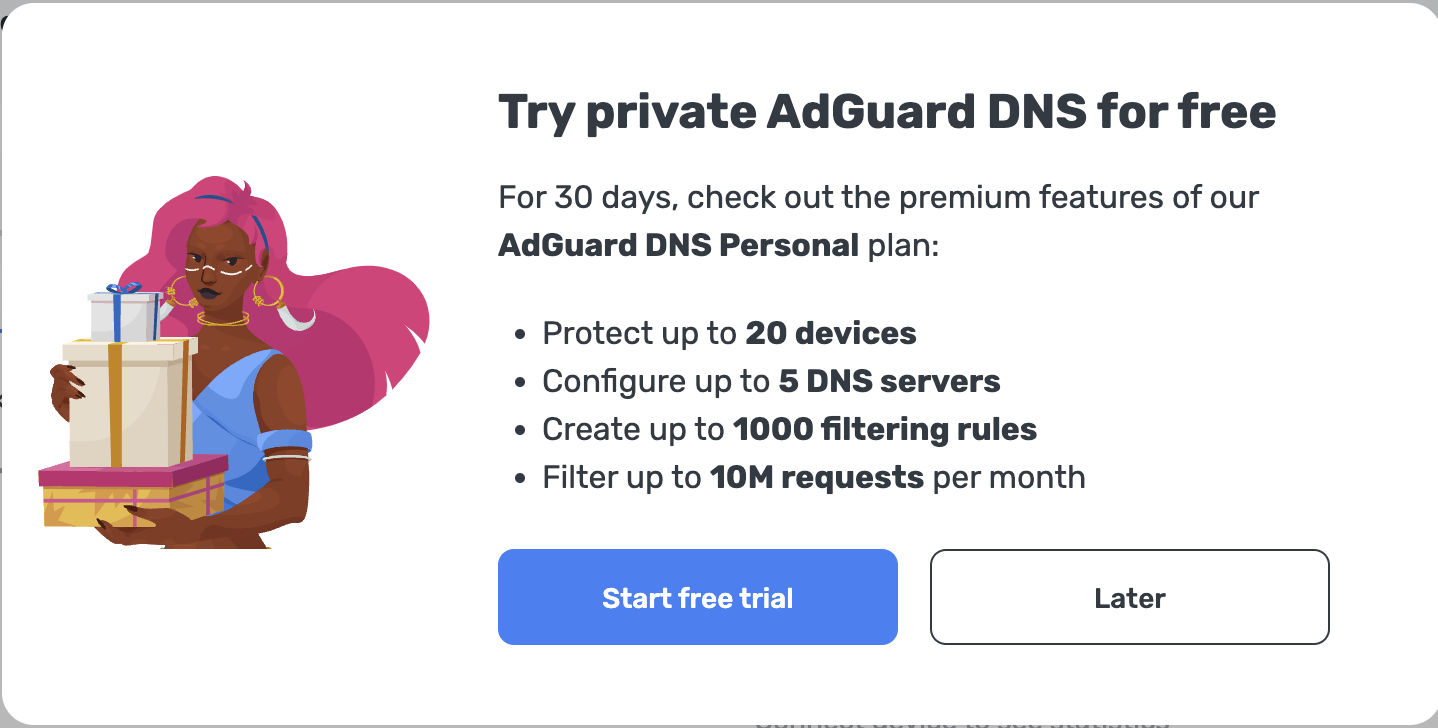
For business use, we’ll ask the user a few more questions and forward the request to our support team. If everything checks out, we’ll provide them with a 30-day trial of either the Team or Enterprise plan.
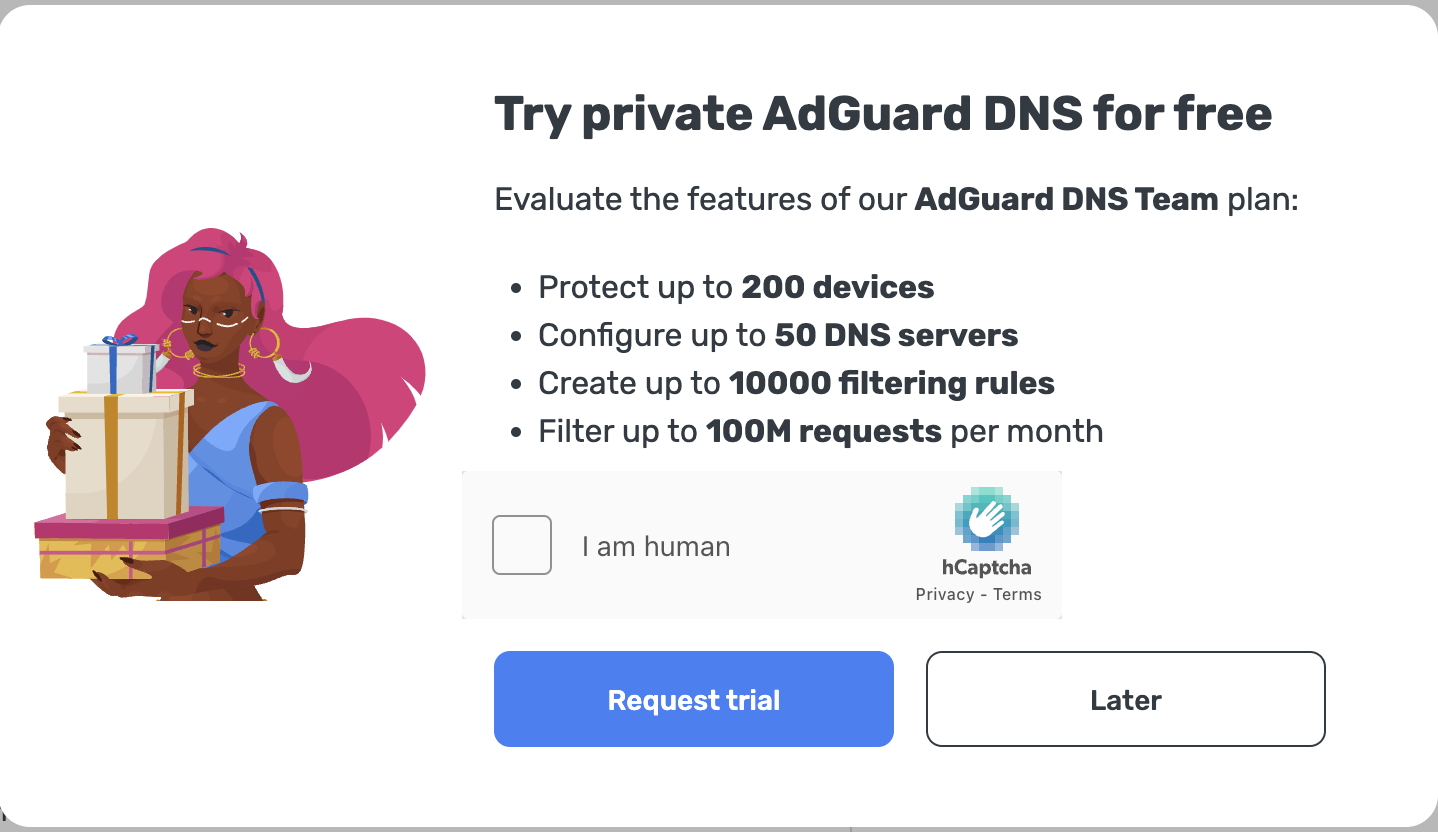
How to get a free trial? Tell your friends who don’t use AdGuard DNS yet: all they need to do is visit the AdGuard DNS website and click Log in in the top right corner. They’ll be prompted to sign up and complete a short survey. That’s it! We’ll be happy to protect them online.
5 thg 12, 2024
In this release, we’ve added a feature for Chrome users — Force preflight mode for prefetching in Chrome. What does it do?
To improve performance, Chrome preloads some pages. To maintain privacy (as Chrome sees it), it uses the private prefetch proxy to load page content. But this means that AdGuard DNS won’t even see the requests for preloaded pages and won’t be able to filter them.
To fix this, we’ve added a feature that forces Chrome to send a DNS request to AdGuard DNS before the user visits a preloaded resource. This allows AdGuard DNS to block the request if necessary.
Please note: this feature doesn’t disable page preloading. To turn it off, go to Chrome settings → Performance → Preload pages.
Changelog
Improvements
Simplified profile configuration names for macOS and iOS #367
Optimized display of requests in Statistics, Query log, and Traffic destination
Added search by description in Blocklists
Fixes
The Block domain and Add user rule buttons in Query log ignore request status
Companies per page selector glitches when opened #855
8 thg 11, 2024
AdGuard DNS is once again the first to cross the finish line and take home all the medals! We’re proud to be the world’s first public DNS resolver to support Structured DNS Errors (SDE) even before it becomes an official standard.
What Structured DNS Errors are
Structured DNS Errors are additional text information in DNS responses that browsers can parse and convert to human-readable format. Currently, when a website is blocked due to DNS filtering, the user sees a generic error message and may not even realize it’s DNS-related. Structured DNS Errors can provide the user with a detailed error explanation, contact information, and the name of the responsible organization.
Unfortunately, we still need browsers to support SDE before users can actually experience this update. But for now, to see Structured DNS Errors in action, you can try our demo extension. It’s available on the Chrome Web Store or on GitHub.
Other improvements: More personalized experience for users and organizations
Our audience includes individuals setting up DNS for their home as well as large organizations. To better understand each user’s needs, we’ve added an onboarding survey to gather information about goals and expected number of devices. This will help us personalize DNS in the future — for example, by providing more information about automation options for those who need it.
7 thg 10, 2024
From custom rate limits to under-the-hood improvements, this release is designed to elevate your experience with AdGuard DNS like never before.
We always try to keep up with our users’ expectations, and this time is no exception. Team and Enterprise subscription users with a large number of devices connected to their account may sometimes encounter rate limits. That’s why in this update we've decided to add an option to set your own request limits.
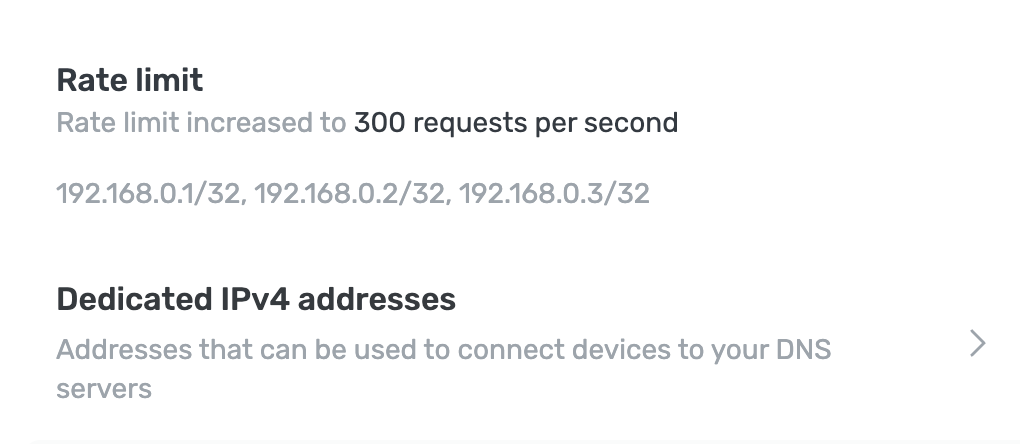
We’ve also fixed a couple of bugs, added a couple of features, and updated instructions for routers.
Changelog
Improvements
Added the ability to set a custom Rate limit for Team and Enterprise subscription users
Updated Private DNS instructions for routers
Added information about the average number of requests per day
Added Brave and Ecosia searchers to Safe Search list
Fixes
New custom rules override previous rules
Device name not updated in filter logs after changing #816
22 thg 7, 2024
We decided not to delay the release of the new version for long. AdGuard DNS v2.8.1 is already here, with fixed bugs and updated Knowledge base.
Changelog
Improvements
Added User API description for automatically connected devices
Fixed
Page doesn't refresh after a server is deleted
Other small fixes
10 thg 7, 2024
In this release, we’ve made it even easier to add many devices. We’ve already told you about AdGuard DNS Client, and now we’ve added another feature — automatic device connection.
We’ve also added a new tag in the country stats for situations where the IP address was not included in the response. Other improvements can be found in the changelog.
Automatic device connection
For some people, connecting new devices from the dashboard isn’t convenient. For example, if you’re setting up devices for the entire company, you may want to simplify the process.
Now you can create a special connection link and enter it in the device settings. We’ll detect the device and automatically connect it to the server.
In Servers → Server settings → Devices, we’ve added a template that will generate a link for the required device and protocol type. And if you prefer to create links manually, there are also instructions.
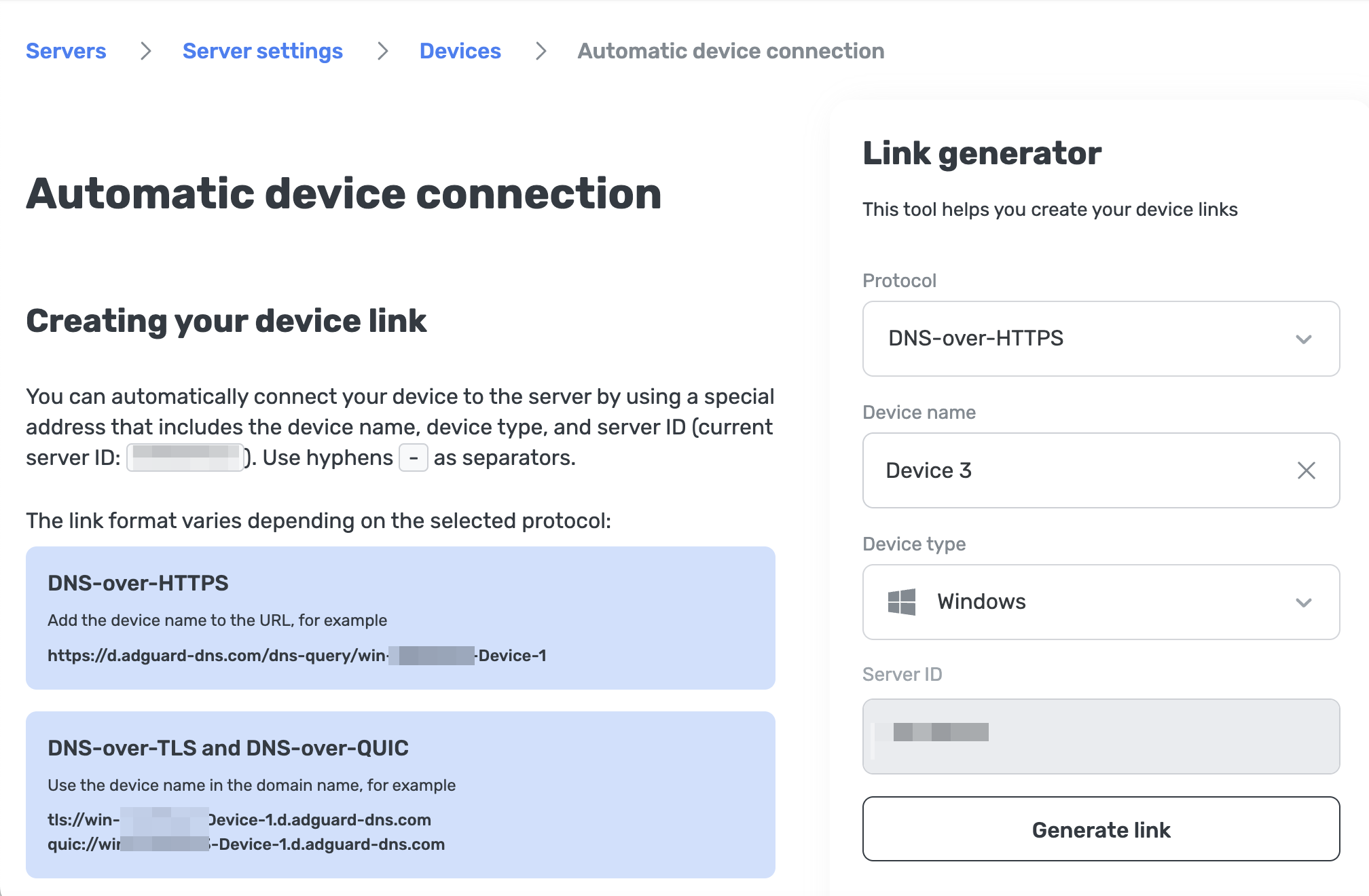
You can allow or prohibit automatic device connection using such links in Servers → Server settings → Devices.
Tag for countries that couldn’t be determined
We’ve been asked from time to time: why is Unknown destination often at the top of the country statistics? This category included requests where the country could not be determined from the IP address or the IP address was not provided.
Now these two cases are separated: Not applicable means that the response doesn’t include an IP address, and Unknown destination means that the country couldn’t be determined from the IP address.
Changelog
Improvements
Added a new section in Devices: Automatic device connection
Added a new request destination type in Statistics: Not applicable
Added a new device type in setup instructions: Other
Added stats period selector in Servers and Devices
Added a DNS server in Toronto
Fixes
Disabling statistics leads to problems loading the dashboard
Page loading error in Request destination
User filter data resets when the page is refreshed
22 thg 4, 2024
Ever had that feeling when you get a haircut but no one seems to notice? Well, we definitely don’t want that. That’s why we’ve put in our best efforts to make sure AdGuard DNS v2.7 won’t go unnoticed: we’ve given the settings and the device connections pages a fresh new look, and we’ve added DNS-over-HTTPS with authentication to give it that final touch of novelty — and security. Let’s take a closer look at these improvements:
DNS-over-HTTPS with authentication
We’ve added the option to use DNS-over-HTTPS with authentication, which, in addition to the device identifier, provides a login and password for it. This can restrict access for unauthorized users and, as a result, enhance your security.
To enable this feature, head to settings of the device in which you’d like to use this authentication option, and change the DNS server to the one with authentication. By clicking Deny other protocols, other protocol usage options to disappear, leaving only the DNS-over-HTTPS authentication enabled and preventing its use by third parties.
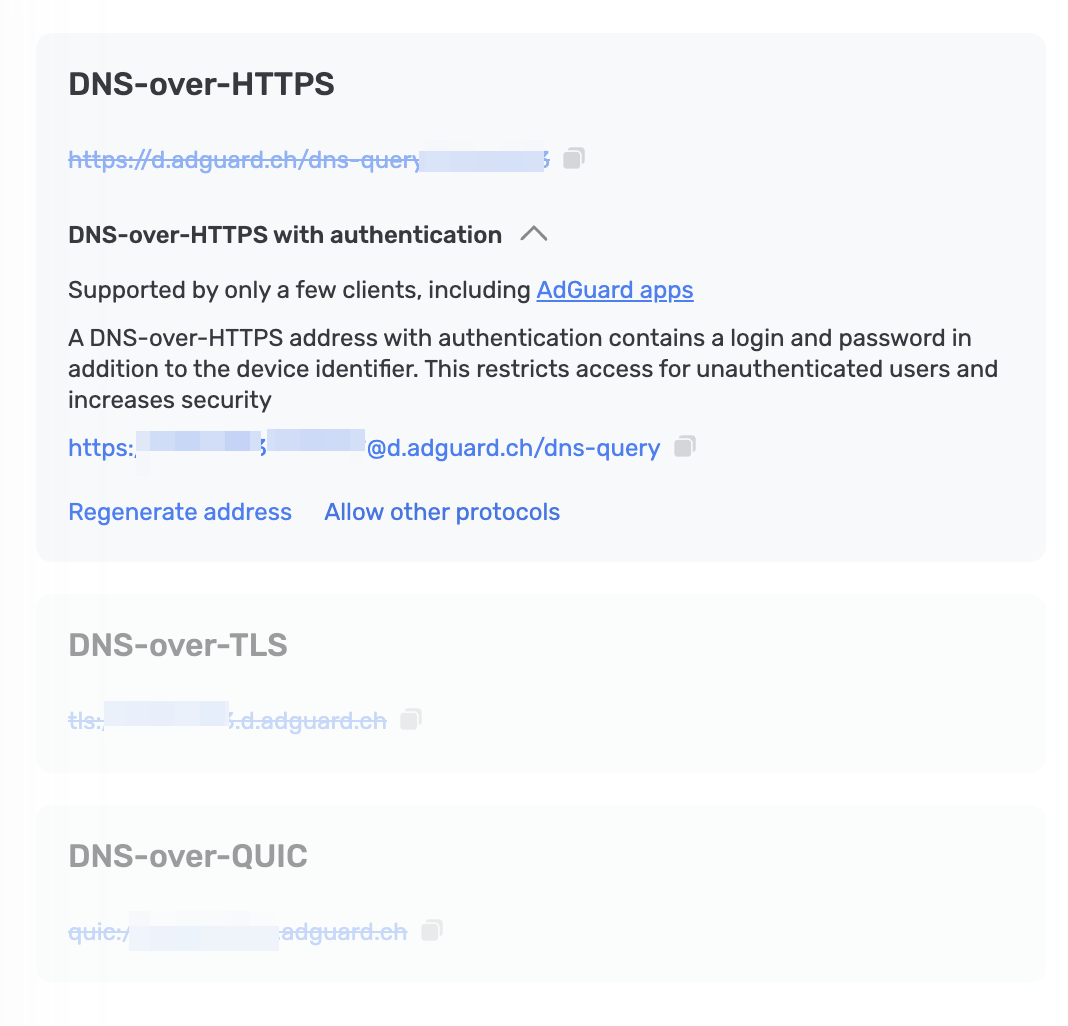
Settings redesign
The settings section has been given a fresh design to make it more user-friendly, aiming for increased efficiency and ease of use. The device configuration page has also undergone changes, allowing for more convenient device management, including the ability to delete all devices with a single click.
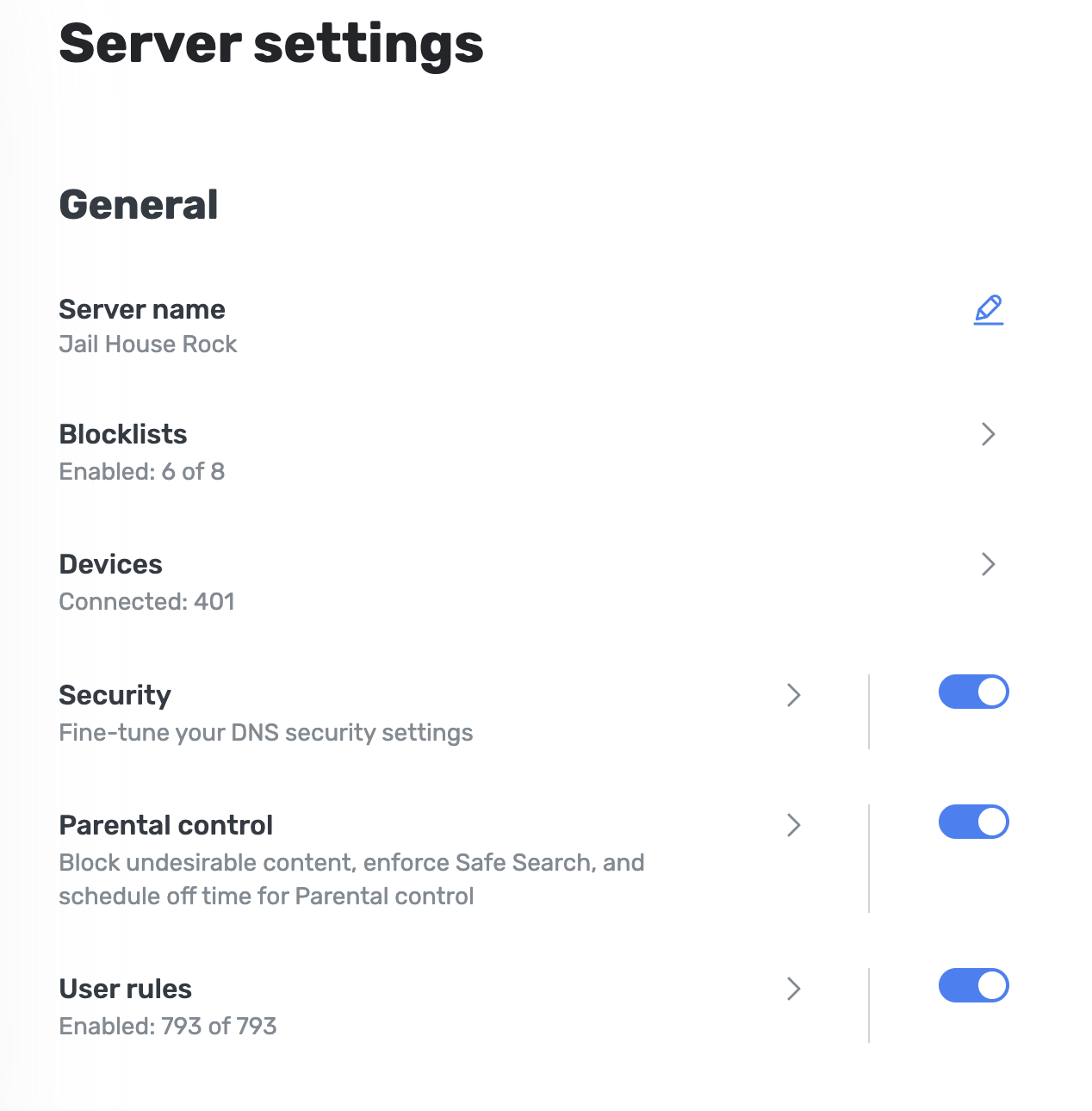
Сhangelog
Features
Added the ability to delete all devices from the server at once
Added the ability to choose the number of devices displayed in server settings
Added the ability to not overwrite user rules during import
Fixes
Fixed behavior of discount coupons during promotions
Made adjustments to the public setup instructions page for AdGuard DNS
YouTube restricted mode is not applied on Firefox #753
1 thg 3, 2024
AdGuard DNS v2.6 is here to sprinkle a little magic into the lives of our Team and Enterprise plan users! This latest version unveils the world of dedicated IPv4 addresses, turning the sometimes daunting task of connecting devices to DNS servers into a breeze.
Dedicated IPv4 addresses
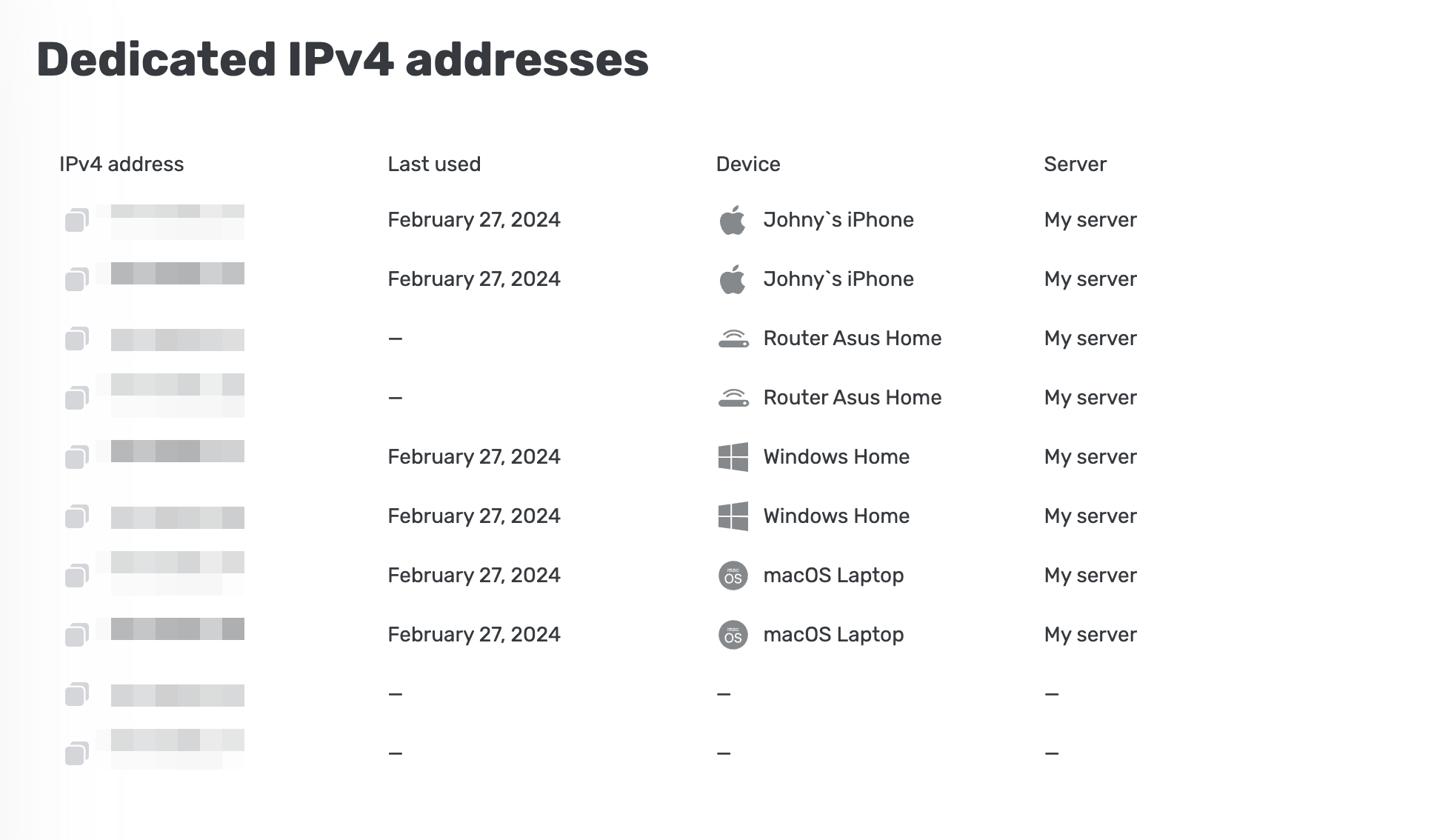
The highlight of this version is the availability of dedicated IPv4 addresses. All you have to do is assign them to the devices of your choice, allowing you to easily connect to private DNS servers swiftly, with quick setup, without compromising your security and ensuring that no one else will be using your server. But how does it improve your experience with AdGuard DNS?
As a user, you’ve probably noticed that setting up AdGuard DNS is not always possible in some devices. For instance, setting up unencrypted DNS on Windows was a demanding task, and linking IP addresses required specialized support and was not always reliable. We hear you!
Since the previous version, we’ve started preparing AdGuard DNS so you can make the most out of encrypted DNS protocols. We began by introducing access settings in v2.5 to allow you to protect your DNS endpoints from unauthorized access, as these addresses are often targeted by various scanners. As a result, your stats may be overwhelmed with unwanted requests. With these settings, it became possible to specify which clients can use your DNS server, list clients that cannot use your DNS server, and specify domains that cannot be accessed via your DNS server.
And that’s how v2.5 set the stage for AdGuard DNS v2.6 to shine: from this new version, dedicated IPv4 addresses are available to you, and now you can enjoy this cool new feature designed especially for those who couldn’t connect to encrypted protocols on their devices.
Changelog
Features
Added instructions in case the device is not recognized on the main AdGuard DNS page
Added instructions for setting up AdGuard Private DNS via
dnsmasq service for Linux usersEnabled blocking lists are now displayed at the top
Fixes
Incorrect error code is displayed when there is no Internet connection
The “Change subscription” text on the main settings page overlaps its field #733
Resetting the domain filter does not work in the Companies section
Overlapping text in the Statistics section
The FAQ section display issue on tablets
Incorrect instruction for setting up AdGuard Private DNS-over-TLS for OpenWRT routers
22 thg 12, 2023
Recently, we released a major update to Private AdGuard DNS. A few minor bugs slipped through the cracks, but we fixed them in their tracks in this version. We also improved the Access settings interface — added tooltips and placeholders, changed the name of the button from Block to Block domain. In a word, we made the settings more intuitive and user-friendly.
Changelog
Fixes
Message "Not enough data. Continue using your device to see statistics here" in the Statistics section is shown if users have data #704.
Incorrect display of access settings and ISP information in the Statistics section and Filtering log
Other minor fixes
18 thg 12, 2023
It’s beginning to look a lot like Christmas… And we’ve got some presents for you, especially if you want to gain more control over your traffic! Meet AdGuard DNS v2.5 with new Access settings and the expanded range of custom rules.
New Access settings
With this release, the new Access settings section became available. What can you set up there and what for? Let’s dive deeper into this topic.

If you go to Server settings → Advanced settings → Access settings, you’ll see three parameters:
Allowed clients. Here you can specify which clients can use your DNS server
Disallowed clients. Here you can specify the clients that are not allowed to use your DNS server
Disallowed domains. Here you can specify the domains (as well as wildcard and DNS filtering rules) that are not be allowed to access your DNS server
By customizing these fields, you’ll be able to protect your AdGuard DNS server from unauthorized access. Blocked requests will not appear in the Query log, and you will not need to pay for them.
There's another reason why we’ve added Access settings. We plan to implement dedicated IPv4 addresses in the nearest future. These addresses are often targeted by various scanners and can be vulnerable to DDoS attacks. To avoid cluttering your stats with these unwanted queries, it's crucial to have the ability to shield your dedicated address from unauthorized access.
More user rules
We know that many of you have been waiting for this: now you can increase the number of available custom rules by upgrading your subscription:
Starter — 100 rules
Personal — 1,000 rules
Team — from 5,000 to 50,000 rules
Enterprise — 50,000+ rules
Changelog
Features
Added the ability to set up private DNS in AdGuard VPN Browser Extension via the link
Added the ability to log client IP addresses and domains
Expanded information on queries in Query log
Added the new Top Clients section to Statistics
Fixes
Tooltips are shown in the AdGuard DNS settings
Impossible to buy a new subscription if the previous one expired
Problem with multi selector in Query Log
Link for setting up Private AdGuard DNS on Apple TV does not open
Data in Query Log is reset when refreshing the page
Incorrect numbering in public AdGuard DNS instructions
2 thg 11, 2023
Here at AdGuard, your online security is our priority, but you already know that. What you probably don’t know yet is that AdGuard DNS v2.4 brings something really special to the table: we've added the ability to shield yourself from those freshly registered, not-so-friendly and often outright malicious domains.
Blocking recently registered malicious domains
Every day, thousands of newly registered domains are created. Most of them, unfortunately, are on the malicious side. These domains are primarily used in phishing attacks and malware distribution and can be used to leak sensitive data. Good news is, with AdGuard DNS v2.4, you don’t have to worry about them: finding the source of these domains used to be a challenge, but we are now able to block them directly on the DNS level, so you can enjoy the Internet more freely.
Redesigned instructions for setting up a Personal DNS
We're here to make your online world not just safer, but also easier to navigate: our revamped setup instructions are all about providing you with the utmost convenience and clarity when configuring your Personal DNS. Besides, if your OS of choice is Windows 11, you can now check the instructions designed specially for it.
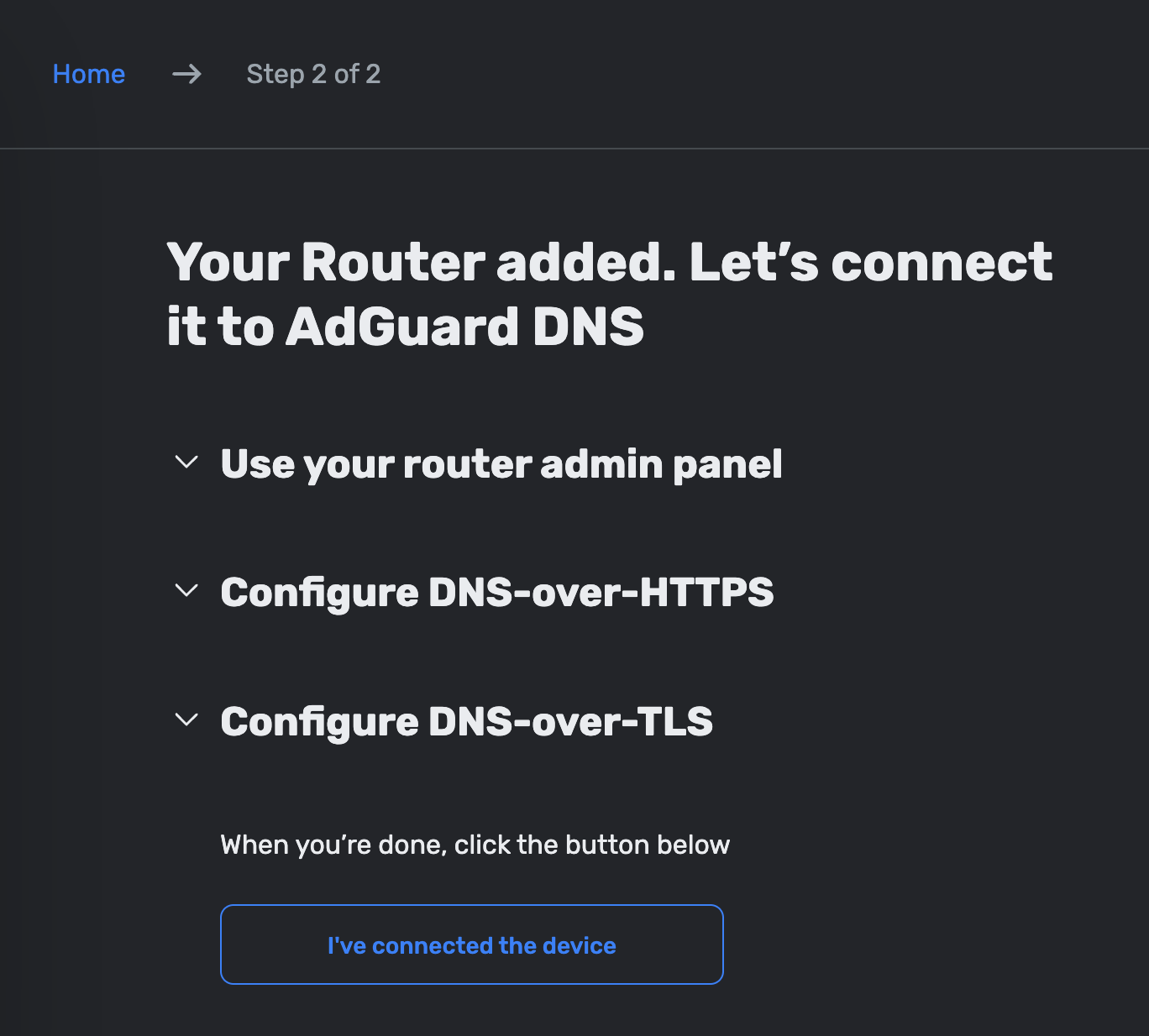
Updates in the Statistics section
Also, we are excited to introduce a new section in the Statistics tab. There, you can sort the traffic by two new categories: encrypted and unencrypted requests.

Welcome to a more secure and user-friendly experience!
Changelog
Features
Added the ability to block recently registered domains #385
Redesigned instructions for setting up the Personal DNS
Added a section in the Statistics for categorizing traffic into encrypted and unencrypted requests
Added instructions for setting up a Personal DNS for Windows 11
Fixes
Fixed the date and time display format for different locales
31 thg 8, 2023
In this release, we're introducing two significant enhancements, both of which simplify the process of connecting devices to your DNS servers.
Dedicated IPv6 addresses
For devices that don’t support encrypted DNS protocols, connecting to your DNS servers has become much simpler! You don’t have to relink your device’s IP address every time it changes. Just enter the dedicated IP addresses in the device settings, and we’ll do the rest.
Not all devices and providers support IPv6. We’re planning to add IPv4 to Private AdGuard DNS soon.
Instructions for routers, TVs, and gaming consoles
In this version, we've also taken care of those who use DNS on devices that require manual setup. Now, when connecting a new device on the dashboard, you can specify the router, smart TV, or console model — and we'll provide you with instructions tailored to that model.
Changelog
Features
Added instructions on how to connect Private AdGuard DNS for routers, game consoles and smart TVs
Added an option to connect private DNS via a dedicated IPv6 address
Optimized filter selectors in Block lists, User rules, and Parental control sections
Fixes
7 thg 8, 2023
In this update, we have improved the DNS server performance, fixed a few issues, and released a new authorization service that will allow users to access their personal account quicker.
Changelog
Performance
The number of AdGuard DNS users is growing at an enormous rate, and the total number of requests per second has closely approached 2 million. Meanwhile, over 90% of these requests come to us through encrypted DNS protocols (DoT, DoH, DoQ, DNSCrypt). Therefore, in this release, we focused on improving the DNS server’s performance and achieved great success. We can now handle an astronomical number of requests with reasonable server power.
Features
Added Czech and Slovak languages
Improved readability of highlighted text in dark theme #617
Full DNS address now displayed when setting up a device in a mobile browser #625
Fixes
24 thg 4, 2023
The highlight of this release is the ability to customize the Team subscription — now you can choose the number of devices, servers, and monthly requests you want before purchasing it. Also, we've added the option to select a response code for blocked requests and, of course, fixed some bugs.
Changelog
Features
Added the ability to customize the Team subscription
Added more information about monthly traffic update #490
Added the option to select a response code for blocked requests
Added AdGuard DNS blog
Updated Linked IP block design
Updated translations #570
Fixes
In the mobile version of Safari, the filtering log automatically reverts to its default state after scrolling
Problem with statistics and log retention settings #472
EDNS Client Subnet could not be disabled #542
Error condition is not reset when the type of line to be added is changed #563
Slashes are not saved in the comments of the user rules editor #576
Real-time query log updates don't retain filter changes #460
Fixed an issue that allowed a DoS attack against the service using malformed UDP packets
1 thg 3, 2023
Minor bugs should be tackled before they build up and affect the performance of AdGuard DNS. We aim to release patches in a timely fashion, and here's another one.
Changelog
Fixed
Can't reach the 'Try AdGuard DNS' button in Safari on iOS #436
The settings of the selected server are reset after refreshing the page
The domain is not found in the search field if it was copy-pasted #530
Changed the hint text for clearing device logs/statistics #536
Added
Default TTL hint #535
Ability to customize which response will be used for a blocked domain
Option to block Mozilla canary domain
2 thg 2, 2023
In this patch we've fixed several bugs — now AdGuard DNS runs better.
Changelog
Fixed
Spikes on the stat graph
Incorrect triggering of the device limit
Resetting statistics does not occur in all filter sections
Unable to log in to account via Apple ID if 2FA is enabled
Top blocked domains and top requested domains values in mobile version are mixed up #482
Resetting filters in filtering log does not clear domain search field #524
29 thg 12, 2022
This patch is a little New Year’s present for you. We’ve significantly improved the performance of our DNS servers, added instructions for connecting AdGuard DNS to AdGuard VPN and AdGuard Browser extension, and fixed minor bugs.
7 thg 12, 2022
Now it’s possible to connect an Android or iOS device with AdGuard VPN to AdGuard DNS via email. To do so:
Open the AdGuard DNS dashboard and tap the Connect new device button,
Choose Android or iOS and enter your device’s name,
Tap Next and then Send link by email,
Enter the email address you want to send the link to and click Send,
Open the email on the device you want to connect to AdGuard DNS and tap the Connect device button.
For this release we’ve also expanded the list of used filters, made some UI enhancements, fixed a few bugs, and added Vietnamese localization.
Added
Option to connect AdGuard DNS in the AdGuard VPN app by sending a configuration email
Vietnamese language support
Added filters
1Hosts (mini)
HaGeZi Personal Black & White
HUN: Hufilter
LIT: EasyList Lithuania
No Google
Fixed
AdGuard DNS homepage doesn’t load when iCloud+ Private Relay is enabled
22 thg 11, 2022
In AdGuard DNS v2.1.2 we’ve enhanced the dashboard interface, added a server in Johannesburg and an option to disable automatic filtering log updates. Also, we’ve fixed some bugs so it will no longer be a problem to rename the device or understand the statistical report.
If you use AdGuard VPN for Android or iOS, you can easily add an encrypted DNS to your device. Just follow our instructions when adding a new device.
Added
Fixed
25 thg 10, 2022
This hotfix is intended to correct minor errors and add two localizations as a bonus.
Changelog
20 thg 10, 2022
AdGuard DNS now supports DNS-over-HTTP/3 in experimental mode. It was a challenge, but we made it. For now only AdGuard Home and dnsproxy fully support DNS-over-HTTP/3, but soon DoH3 will appear in other AdGuard products. However, we focus on DNS-over-QUIC and consider it more advanced, but we strive to support the other protocols too, and DoH3 is a proof of that.
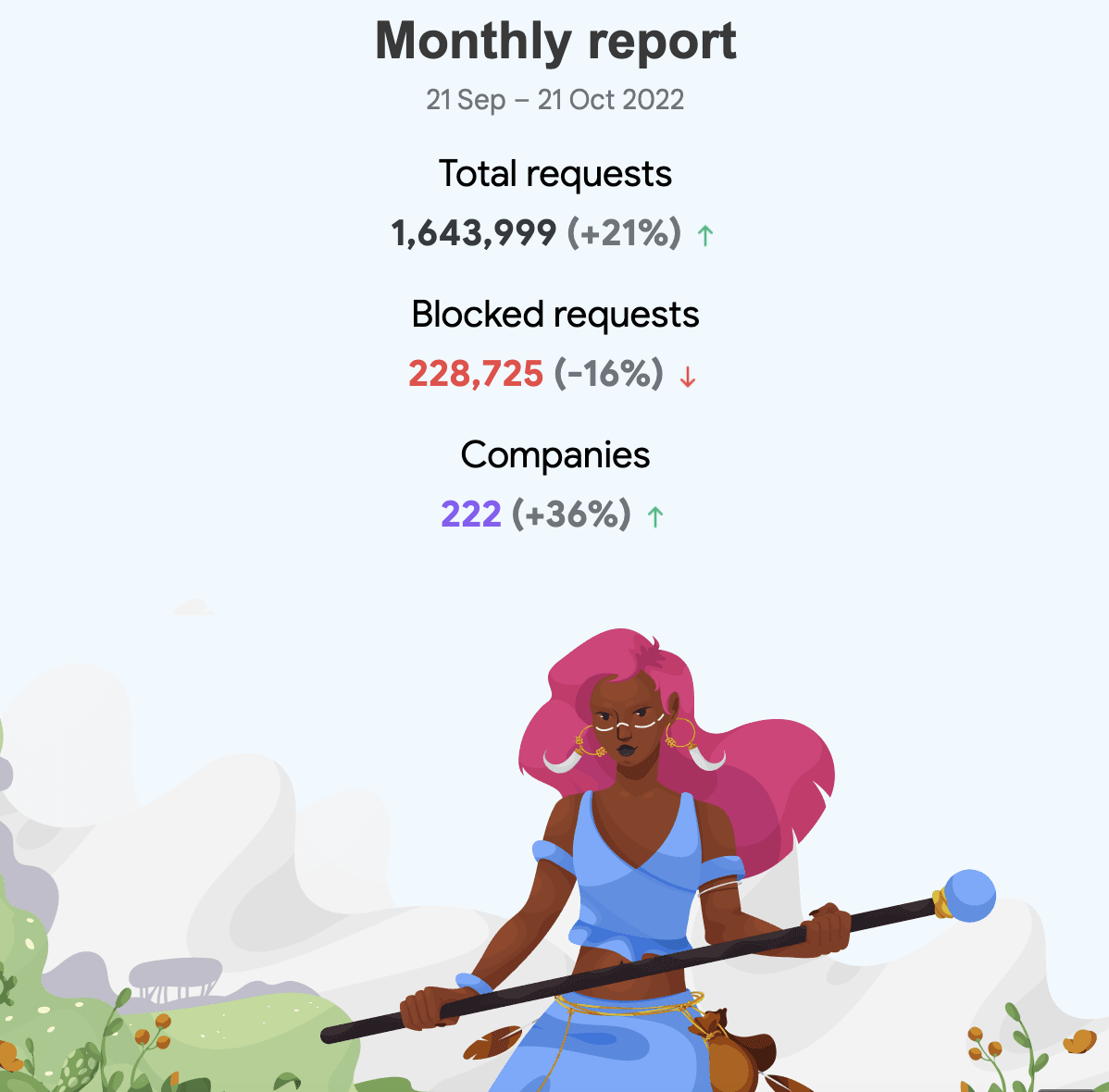
Another good news is that we will email AdGuard DNS users weekly and monthly reports with stats on requests, devices, and companies, which is convenient and visual. If there are too many reports, you can unsubscribe at any time.
Changelog
[Enhancement] Added the Apply button that appears after changing the server name
[Enhancement] Query log data cutoff in desktop mode #366
[Enhancement] Query log page numbers move when a new page is opened #368
[Fixed] Switching from 90 days to anything less causes dates to overlap #323
[Fixed] Text is cut off for the last domain in Top domains #339
[Fixed] Dates are cut off on the left and right side of the chart (mobile version of the website) #341
[Fixed] Misleading subscription status (from AdGuard VPN) #352
[Fixed] Wrong status of applied unblocking rules #361
[Fixed] The "Refresh" button on the homepage does not override the number of requests
[Fixed] Query log data is cut off (desktop version of the website) #366
[Fixed] Limit triggering in Enterprise plan
[Fixed] Can't scroll to account settings on Safari for macOS #353
[Fixed] In some cases the statistics were counted incorrectly
[Fixed] Top Destinations stats overlap when set to 90 days #326
7 thg 9, 2022
It's been two weeks since the release of AdGuard DNS 2.0, but there's still a pleasant aftertaste. We've been painstakingly working on this product to give you a reliable and convenient tool to control your online traffic. And we succeeded.
Still, small bugs had crept into the release. That's why we're publishing a patch today: so you can enjoy the service, and we can move on to some bigger tasks with peace of mind.
Changelog
[Enhancement] Added search to the DNS knowledge base
[Enhancement] Updated link for Contact Us button on purchase page
[Enhancement] Improved the Traffic Destinations page
[Enhancement] Add an option to use
add-cpe-id in Dnsmasq to identify the device[Fixed] Disabling logs disables tariff statistics
[Fixed] Numbers in Japanese, Korean, Chinese are displayed incorrectly
18 thg 8, 2022
The beta testing phase is finally over! From now on the new level of traffic control is available for you. With AdGuard DNS 2.0 you can:
Flexibly configure domain blocking via blocklists, query log and user rules;
See real-time requests statistics from all connected devices;
Enable and set up Parental control;
Learn more about all the changes and improvements of AdGuard DNS 2.0 in our blog.
29 thg 7, 2022
Check out the sixth beta version of AdGuard DNS (and hopefully the final one before the release). In it we’ve improved the dark theme: updated the map styles and QR-code, so that everything could be easily read and scanned. And, of course, we fixed some minor bugs. The private AdGuard DNS now runs smoother!
Changelog
[Enhancement] Updated map styles in the dark theme
[Enhancement] Added an option to disable iCloud Private Relay
[Fixed] QR code is not scanned in the dark theme
[Fixed] Autofill doesn’t work in Safari on macOS and iOS
[Fixed] Minor bug fixes in desktop и mobile versions
13 thg 7, 2022
There are five fingers in a hand, five oceans on Earth, and five betas of the private AdGuard DNS. Today we're releasing the fifth beta of our DNS and we hope you'll rate it 5/5!
In this version we’ve implemented support for DDR (Discovery of Designated Resolvers) by the latest draft of the new standard. With this feature, an encrypted connection to the DNS server will be set up automatically on devices with DDR support, provided the device previously knew the server address. A computer or smartphone will send a request to the known address and receive all the necessary information to establish a secure connection.
DDR support appeared in Windows 11 Insider Preview Build 22489, which means that the feature will get into the release version after a while. When this happens, Windows and AdGuard DNS users will be automatically reconnected to encrypted DNS servers – public or private, depending on the services selected earlier.
We’ve also improved ECS (EDNS Client Subnet) implemented in the third beta. Servers now respond with more precise IP addresses that better match your location. Furthermore, we are continuing to refine the open AdGuard DNS API, and now there are methods for getting statistics. All documentation is available at Knowledge Base.
We’ve fixed some bugs and worked on the interface: authorization via Apple ID now works properly, the dark theme has become really dark, and the Query log is prettier than ever. French, Italian, Chinese, Japanese, and Korean were added to the dashboard, and we are committed to continue localizing the private AdGuard DNS, making it accessible to users from all over the world!
Changelog
[Enhancement] Added support for DDR (Discovery of Designated Resolvers)
[Enhancement] Statistic retrieval methods were added to the API
[Enhancement] Added an option to change subscription type
[Enhancement] Added an option to extend subscription
[Enhancement] Added support for Chinese, Japanese, Korean, French, and Italian
[Enhancement] Added the "Don’t ask again" checkbox to the system notification that appears when deleting user rules
[Fixed] After logging in via Apple ID the personal account opens instead of dashboard if the user has an AdGuard VPN subscription
[Fixed] In dark theme statistics blocks are highlighted in white
[Fixed] In dark theme text in some fields is grayed out
[Fixed] Some elements in the mobile version of the website are displayed incorrectly
21 thg 6, 2022
The period of active "building" of the private AdGuard DNS is left behind, and now we're polishing the service to a shine. Just take a look at the current changelog and compare it to the one we published for the previous beta. The difference is obvious.
The fourth beta features dark theme and language selection – at the moment, the dashboard is translated into German, Spanish, and Russian. To find both options, go to Account settings. And some more good news: from now on all AdGuard VPN users with a subscription will get the Personal plan of the private AdGuard DNS for free.
We hope you’ll enjoy the new version. Use the service and leave feedback on any platform you like.
Changelog
[Enhancement] Added dark theme
[Enhancement] Added support for VPN subscriptions and information about VPN subscribers automatically getting a Personal DNS subscription
[Enhancement] Added German and Spanish localizations
[Enhancement] Improved search function in the filter section on mobile devices
[Enhancement] Supplemented instructions for different devices
[Enhancement] Added a link to DNS rules syntax in the query log dialog
[Fixed] The “View device settings” button doesn't work on iOS devices
[Fixed] The “Unable to renew subscription” popup hangs for too long
10 thg 6, 2022
The recently released third beta of private AdGuard DNS was really good and brought a lot of useful features to users. However, as it turned out, it contained a few flaws. So that you don't have to deal with them anymore, we are releasing a patch v0.3.1 for private AdGuard DNS.
Changelog
[Fixed] Clicking the Block button in Query log deletes all existing user rules and replaces them with a new one #265
[Fixed] Unable to move devices between servers #248
[Fixed] Incorrect links on the "Thanks for your purchase" page
[Fixed] Discount promo codes do not work correctly
[Fixed] There is no payment button in the mobile version of the website
[Fixed] Incorrect designation of the number of requests in Statistics
26 thg 5, 2022
Meet the third beta version of private AdGuard DNS! We are steadily moving towards a full-fledged product, adding new features, changing and improving UI — everything to make you really enjoy using AdGuard DNS.
The version history – in front of your eyes
First and foremost, we've added a version history page for the AdGuard DNS service. Now you can see the full list of changes, learn about new features, and see how the work on private AdGuard DNS service is progressing.
Contribute to AdGuard DNS translation
Until now, private AdGuard DNS could only be used in English: first we had to make sure everything was working as it should. With this version we've extended the geography by adding the possibility to translate the dashboard into different languages. Help us make AdGuard DNS more accessible to everyone by participating in the translations! You can find a detailed article on how to use the Crowdin platform in our Knowledge Base. And if you already know how to use it, visit the AdGuard DNS project in Crowdin. Select the Dashboard and choose the language you want, then you're ready to translate!
AdGuard DNS Knowledge Base
To make it easier to understand AdGuard DNS, we've added the Knowledge Base. You can see all the latest Knowledge Base changes in the AdGuard DNS GitHub repository.
Subscription
We've added a paid subscription on private AdGuard DNS. Subscription is not required during beta testing, but we'd appreciate it if you'd like to support us now.
DNS filters
We've also fixed DNS filters: eliminated the bug with the
/etc/hosts-style rules failing to work and added support for rules with $dnsrewrite. By the way, you can read about the DNS filtering syntax in the Knowledge Base.ECS support
The AdGuard DNS servers now support EDNS Client Subnet (ECS).
This feature allows users to get responses corrected for the location of the DNS user. We had long been hesitating to implement it in AdGuard DNS: ECS assumes handing over an anonymized user's IP address to the name server. In this version, we've solved the problem: instead of the user's IP address, we pass another address from approximately the same location as the user's.
New blocklists
We've added a lot of new blocklists — now it's even easier to customize AdGuard DNS. And if that's not enough, you can request and add more blocklists in the GitHub repository (before you do that, read requirements for blocklists in the section “What Blocklists Can Be Added Here”).
Open API
AdGuard DNS now has an open API. If you want to integrate with AdGuard DNS, read the documentation.
UI fixes and more
We've also fixed a lot of minor bugs and added some useful features.
Test private AdGuard DNS and leave feedback on any convenient platforms — it will help us become better.
Changelog
[Enhancement] Improved the appearance of the multiselect (element with the ability to select multiple values, such as countries, devices)
[Enhancement] For the device location, the Traffic Destination section uses data from its last activity
[Fixed] Incorrect detection for account time zone
[Fixed] Statistics and logs do not get cleared when their retention period is changed
[Fixed] Incorrect country detection for some domains
[Fixed] Significant delay in clearing logs and statistics
[Other] Added the option "Last 7 days" to date selector
16 thg 3, 2022
We’ve all been waiting for it: we're proud to present the open beta of private AdGuard DNS! From now on, anyone can set up their own DNS server.
We took the best of AdGuard DNS and AdGuard Home and designed a product that would be flexible and customizable, meet the needs of "geeks", and have a user-friendly interface. We hope we succeeded! And now let's take a closer look at the best features of private AdGuard DNS.
Block/unblock domains
With a private DNS server, it is only you who decides which domains should be blocked and which shouldn’t — on each device! Connect your computer, smartphone, tablet or router and manage their requests as desired.
Blocklists management
You can also choose which domain blocking rules should be implemented. And those who aren't satisfied with dozens of pre-installed blocklists can import and export their own custom rules.
Advanced statistics
Now you can see the full statistics of your requests: how many requests were registered, to which companies, and to which countries. Besides, you can view this information for different dates, countries, and even for different devices connected to your DNS server. And of course, block and unblock requests on the go.
Parental control
To protect your child from online content you deem inappropriate, you can use Parental control. You can activate the safe search and manually specify domains for blocking as well as set the schedule: for instance, not allow your child to watch videos during homework.
Join beta testing
To take part in beta testing go to AdGuard DNS website and press *Join beta***, then sign up or log into your AdGuard account. You're done! Create your own DNS server and manage your requests — you are in control.
28 thg 9, 2021
Great news: AdGuard DNS is advancing to a new level. We're about to release the product that many have yearned for so long — the private AdGuard DNS!
What a public DNS server blocks cannot be changed — it only has to be taken for granted. With your own DNS server, you'll be in control of all the query statistics and be able to choose which domains you want to block. It'll allow you to add blocklists and set up Parental control. And the user-friendly interface will make it no problem to get to grips with it all.
We added a new website where you can already see what the private AdGuard DNS interface will look like, learn how to connect to the public DNS server, and subscribe to the AdGuard DNS newsletter. If you do, we'll message you at launch and keep you up-to-date with the latest AdGuard news.
Thank you for your support! Stay tuned — and in the meantime, we're working to make sure the next release is to your liking.